A New Measure for Serious Games Evaluation: Gaming Educational Balanced (GEB) Model
Abstract
Featured Application
Abstract
1. Introduction
2. Materials and Methods
2.1. Previous Serious Games Studies: MDA and 4PEG Models
2.2. Gaming Educational Balanced Model
2.2.1. Game Overview
Game Mechanics
Game Dynamics
Aesthetics
Technology and User Experience
2.2.2. Educational Overview
Instructional Strategies
Motivational Design
- Backstory and Production
- Realism
- AI and Adaptivity
- Interaction
- Feedback and Debriefing
2.2.3. Overall Balance
Learning and Fun Balance
Can Learn vs. Must Learn
2.2.4. Omitted Issues
- Content and Originality. Evaluated under this point are the appropriateness of the genre for the educational goal and the originality of the game compared to others. These characteristics have previously been explained in the GEB Instructional Strategies section.
- Game Progression. This paragraph measures the difficulty of transition throughout the gameplay. The aspect is included in AI and Adaptivity, belonging to the Motivational Design section.
- Settings and Characters. This feature relates to the adaptation of the game elements to the learning content and type of player. The Educational Overview evaluates these characteristics in the Backstory and Production and Realism guides.
- Objectives. This point does not correspond to any of the ARCS model features which are described in the Motivational Design subsection. On the contrary, this aspect is related to the explanation of the contents in the Instructional Strategies section. The objectives are used to evaluate the adequacy of the game for its purpose and its adaptability to various contexts.
- Operational vs. Educational Learning: For the evaluation of learning, its evolution and its adaptation to the learning goals. These characteristics are evaluated under the GEB Instructional strategies and AI and Adaptivity sections.
- Educational vs. Discretionary Learning: An aspect that regards the ability to keep the player engaged with the experience to achieve the educational aim. These features are determined in the Backstory and Production process.
3. Results
3.1. GEB Metric Evaluation and Analysis Process
3.2. Analysis Results of GEB Metric
3.3. Statistical and Machine-Learning Validation of the Games Evaluation
4. Conclusions
Supplementary Materials
Author Contributions
Funding
Informed Consent Statement
Data Availability Statement
Acknowledgments
Conflicts of Interest
References
- Checa, D.; Bustillo, A. A review of immersive virtual reality serious games to enhance learning and training. Multimed. Tools Appl. 2020, 79, 5501–5527. [Google Scholar] [CrossRef]
- Huang, W.; Roscoe, R.D.; Johnson-Glenberg, M.C.; Craig, S.D. Motivation, engagement, and performance across multiple virtual reality sessions and levels of immersion. J. Comput. Assist. Learn. 2021, 37, 745–758. [Google Scholar] [CrossRef]
- Ravyse, W.S.; Seugnet Blignaut, A.; Leendertz, V.; Woolner, A. Success factors for serious games to enhance learning: A systematic review. Virtual Real. 2016, 21, 31–58. [Google Scholar] [CrossRef]
- Lai, J.W.M.; Bower, M. Evaluation of technology use in education: Findings from a critical analysis of systematic literature reviews. J. Comput. Assist. Learn. 2019, 36, 241–259. [Google Scholar] [CrossRef]
- Ferreira De Almeida, J.L.; dos Santos Machado, L. Design requirements for educational serious games with focus on player enjoyment. Entertain. Comput. 2021, 38, 100413. [Google Scholar] [CrossRef]
- Mitgutsch, K.; Alvarado, N. Purposeful by design? A Serious Game Design Assessment Framework. In Proceedings of the International Conference on the Foundations of Digital Games—FDG’12, Raleigh, NC, USA, 29 May–1 June 2012. [Google Scholar]
- Mayer, I. Towards a Comprehensive Methodology for the Research and Evaluation of Serious Games. Procedia Comput. Sci. 2012, 15, 233–247. [Google Scholar] [CrossRef]
- Nasution, N.K.G.; Jin, X.; Singgih, I.K. Classifying games in container terminal logistics field: A systematic review. Entertain. Comput. 2022, 40, 100465. [Google Scholar] [CrossRef]
- Hunicke, R.; Leblanc, M.; Zubek, R. MDA: A formal approach to game design and game research. In Proceedings of the AAAI Workshop on Challenges in Game AI, San José, CA, USA, 25–29 July 2004. [Google Scholar]
- Becker, K. Choosing and Using Digital Games in the Classroom: A Practical Guide; Advances in Game-Based Learning; Springer International Publishing: Berlin/Heidelberg, Germany, 2017. [Google Scholar]
- Martinez, K.; Menéndez-Menéndez, M.I.; Bustillo, A. Awareness, Prevention, Detection, and Therapy Applications for Depression and Anxiety in Serious Games for Children and Adolescents: Systematic Review. JMIR Serious Games 2021, 9, e30482. [Google Scholar] [CrossRef]
- Dankov, Y.; Antonova, A.; Bontchev, B. Adopting User-Centered Design to Identify Assessment Metrics for Adaptive Video Games for Education. In Interaction, Emerging Technologies and Future Systems V; Springer: Berlin/Heidelberg, Germany, 2021; pp. 289–297. [Google Scholar] [CrossRef]
- Suryapranata, L.K.P.; Soewito, B.; Kusuma, G.P.; Gaol, F.L.; Warnars, H.L.H.S. Quality measurement for serious games. In Proceedings of the 2017 International Conference on Applied Computer and Communication Technologies (ComCom), Tumkur, Karnataka, India, 21–23 December 2017. [Google Scholar] [CrossRef]
- Becker, K. Instructional ethology: Reverse engineering for serious design of educational games. In Proceedings of the Future Play, The International Conference on the Future of Game Design and Technology, Toronto, ON, Canada, 15–17 November 2007. [Google Scholar]
- Junior, R.; Silva, F. Redefining the MDA Framework—The Pursuit of a Game Design Ontology. Information 2021, 12, 395. [Google Scholar] [CrossRef]
- Kim, J.T.; Lee, W. Dynamical model for gamification of learning (DMGL). Multimed. Tools Appl. 2015, 74, 8483–8493. [Google Scholar] [CrossRef]
- Winn, B.M. The Design, Play, and Experience Framework. In Handbook of Research on Effective Electronic Gaming in Education; IGI Global: Hershey, PA, USA, 2009; pp. 1010–1024. [Google Scholar] [CrossRef]
- Kaufman, G.; Flanagan, M. A psychologically “embedded approach to designing games for prosocial causes. Cyberpsychology J. Psychosoc. Res. Cyberspace 2015, 9, 5. [Google Scholar] [CrossRef]
- Pereira, M.; Winn, B.; Cerazotto, M.; Luiz, A.; Varella, P. Educational Digital Games: A theoretical framework about design models, learning theories and user experience. In Proceedings of the 7th International Conference, Design, User Experience and Usability, Theory and Practice, Las Vegas, NV, USA, 15–20 July 2018. [Google Scholar]
- Caserman, P.; Hoffmann, K.; Müller, P.; Schaub, M.; Straßburg, K.; Wiemeyer, J.; Bruder, R.; Göbel, S. Quality Criteria for Serious Games: Serious Part, Game Part, and Balance. JMIR Serious Games 2020, 8, e19037. [Google Scholar] [CrossRef]
- Toh, W.; Kirschner, D. Self-directed learning in video games, affordances and pedagogical implications for teaching and learning. Comput. Educ. 2020, 154, 103912. [Google Scholar] [CrossRef]
- Lu, Y.L.; Lien, C.J. Are They Learning or Playing? Students’ Perception Traits and Their Learning Self-Efficacy in a Game-Based Learning Environment. J. Educ. Comput. Res. 2019, 57, 1879–1909. [Google Scholar] [CrossRef]
- Alexiou, A.; Schippers, M.C. Digital game elements, user experience and learning: A conceptual framework. Educ. Inf. Technol. 2018, 23, 2545–2567. [Google Scholar] [CrossRef]
- Whitton, N.; Langan, M. Fun and games in higher education: An analysis of UK student perspectives. Teach. High. Educ. 2018, 24, 1000–1013. [Google Scholar] [CrossRef]
- Greipl, S.; Moeller, K.; Ninaus, M. Potential and limits of game-based learning. Int. J. Technol. Enhanc. Learn. 2020, 12, 363. [Google Scholar] [CrossRef]
- Namkoong, K.; Nah, S.; Record, R.A.; van Stee, S.K. Communication, Reasoning, and Planned Behaviors: Unveiling the Effect of Interactive Communication in an Anti-Smoking Social Media Campaign. Health Commun. 2016, 32, 41–50. [Google Scholar] [CrossRef]
- Yang, J.C.; Chen, S.Y. An investigation of game behavior in the context of digital game-based learning: An individual difference perspective. Comput. Hum. Behav. 2020, 112, 106432. [Google Scholar] [CrossRef]
- Connolly, T.M.; Boyle, E.A.; MacArthur, E.; Hainey, T.; Boyle, J.M. A systematic literature review of empirical evidence on computer games and serious games. Comput. Educ. 2012, 59, 661–686. [Google Scholar] [CrossRef]
- Jacobs, R.S. Serious games: Play for change. In The Video Game Debate 2; Kowert, R., Quandt, T., Eds.; Routledge: London, UK, 2020; pp. 19–40. [Google Scholar] [CrossRef]
- Rosenthal, S.; Ratan, R.A. Balancing learning and enjoyment in serious games: Kerbal Space Program and the communication mediation model. Comput. Educ. 2022, 182, 104480. [Google Scholar] [CrossRef]
- Czauderna, A.; Guardiola, E. The Gameplay Loop Methodology as a Tool for Educational Game Design. Electron. J. e-Learn. 2019, 17, 207–221. [Google Scholar] [CrossRef]
- Moizer, J.; Lean, J.; Dell’Aquila, E.; Walsh, P.; Keary, A.A.; O’Byrne, D.; di Ferdinando, A.; Miglino, O.; Friedrich, R.; Asperges, R.; et al. An approach to evaluating the user experience of serious games. Comput. Educ. 2019, 136, 141–151. [Google Scholar] [CrossRef]
- Hamari, J.; Shernoff, D.J.; Rowe, E.; Coller, B.; Asbell-Clarke, J.; Edwards, T. Challenging games help students learn: An empirical study on engagement, flow and immersion in game-based learning. Comput. Hum. Behav. 2016, 54, 170–179. [Google Scholar] [CrossRef]
- Sharma, T.G.; Hamari, J.; Kesharwani, A.; Tak, P. Understanding continuance intention to play online games: Roles of self-expressiveness, self-congruity, self-efficacy, and perceived risk. Behav. Inf. Technol. 2020, 41, 348–364. [Google Scholar] [CrossRef]
- Chen, C.C.; Tu, H.Y. The Effect of Digital Game-Based Learning on Learning Motivation and Performance under Social Cognitive Theory and Entrepreneurial Thinking. Front. Psychol. 2021, 12, 750711. [Google Scholar] [CrossRef]
- Sanchez, D.R.; Nelson, T.; Kraiger, K.; Weiner, E.; Lu, Y.; Schnall, J. Defining motivation in video game-based training: Exploring the differences between measures of motivation. Int. J. Train. Dev. 2021, 26, 1–28. [Google Scholar] [CrossRef]
- Benton, L.; Vasalou, A.; Barendregt, W.; Bunting, L.; Révész, A. What’s Missing: The Role of Instructional Design in Children’s Games-Based Learning. In Proceedings of the 2019 CHI Conference on Human Factors in Computing Systems, Glasgow, UK, 4–9 May 2019. [Google Scholar] [CrossRef]
- Alves, F. Gamification: Como Criar Experiências de Aprendizagem Engajadoras: Um Guía Completo: Do conceito à Prática, 2nd ed.; DVS Editora: São Paulo, Brazil, 2015. [Google Scholar]
- Buley, L. The User Experience Team of One; Roselfeld: New York, NY, USA, 2013. [Google Scholar]
- Garrett, J.J. The Elements of User Experience: User-Centered Design for the Web and Beyond, 2nd ed.; New Riders: Berkeley, CA, USA, 2011. [Google Scholar]
- Malone, T.W. What Makes Things Fun to Learn? A Study of Intrinsically Motivating Computer Games; Palo Alto Research Center (Xerox): Palo Alto, CA, USA, 1980. [Google Scholar]
- Malone, T.W.; Lepper, M.R. Making learning fun: A taxonomy of intrinsic motivations for learning. In Aptitude, Learning and Instruction III: Conative and Affective Process Analyses; Snow, R.E., Farr, M.J., Eds.; Erlbaum: Hillsdale, NJ, USA, 1987; pp. 223–253. [Google Scholar]
- Biles, M.L.; Plass, J.L.; Homer, B.D. Designing Digital Badges for Educational Games. In Learning and Performance Assessment: Concepts, Methodologies, Tools, and Applications; IGI Global: Hershey, PA, USA, 2020; pp. 1349–1369. [Google Scholar] [CrossRef]
- Ferrara, J. Playful Design: Creating Game Experiences in Everyday Interfaces; Rosenfeld Media: New York, NY, USA, 2012. [Google Scholar]
- Miceli, M.; Castelfranchi, C. Meta-emotions and the complexity of human emotional experience. New Ideas Psychol. 2019, 55, 42–49. [Google Scholar] [CrossRef]
- Bailen, N.H.; Wu, H.; Thompson, R.J. Meta-emotions in daily life: Associations with emotional awareness and depression. Emotion 2019, 19, 776–787. [Google Scholar] [CrossRef]
- Fokides, E.; Atsikpasi, P.; Kaimara, P.; Deliyannis, I. Factors Influencing the Subjective Learning Effectiveness of Serious Games. J. Inf. Technol. Educ. Res. 2019, 18, 437–466. [Google Scholar] [CrossRef]
- Menezes, F.M.; Silva, I.C.S.; Frosi, F.O. Game User Experience (UX): Explorando a Teoria da Diegese. In Proceedings of the SBGames 2017 (XVI SBGames (SBC)), São Paulo, SP, Brazil, 2–4 November 2017. [Google Scholar]
- Buil, I.; Catalán, S.; Martínez, E. Exploring students’ flow experiences in business simulation games. J. Comput. Assist. Learn. 2018, 34, 183–192. [Google Scholar] [CrossRef]
- Scholtz, B.; Raga, L.; Baxter, G. Design and Evaluation of a «Gamified» System for Improving Career Knowledge in Computing Sciences. Afr. J. Inf. Commun. (AJIC) 2016, 2016, 7–32. [Google Scholar] [CrossRef][Green Version]
- Cheng, M.-T.; Su, T.; Huang, W.-Y.; Chen, J.-H. An educational game for learning human immunology: What do students learn and how do they perceive? Br. J. Educ. Technol. 2014, 45, 820–833. [Google Scholar] [CrossRef]
- Zin, N.; Yue, W.S. Design and evaluation of history Digital Game Based Learning (DGBL) software. J. Next Gener. Inf. Technol. 2013, 4, 9–24. [Google Scholar] [CrossRef]
- Jonassen, D.H. Thinking technology: Toward a constructivist design model. Educ. Technol. 1994, 34, 34–37. [Google Scholar]
- Barab, S.; Pettyjohn, P.; Gresalfi, M.; Volk, C.; Solomou, M. Game-based curriculum and transformational play: Designing to meaningfully positioning person, content, and context. Comput. Educ. 2012, 58, 518–533. [Google Scholar] [CrossRef]
- Hong, J.-C.; Tsai, C.-M.; Ho, Y.-J.; Hwang, M.-Y.; Wu, C.-J. A comparative study of the learning effectiveness of a blended and embodied interactive video game for kindergarten students. Interact. Learn. Environ. 2013, 21, 39–53. [Google Scholar] [CrossRef]
- Hwang, G.-J.; Wu, P.-H.; Chen, C.-C. An online game approach for improving students’ learning performance in web-based problem-solving activities. Comput. Educ. 2012, 59, 1246–1256. [Google Scholar] [CrossRef]
- Dillard, J.P.; Shen, L. On the nature of reactance and its role in persuasive health communication. Commun. Monogr. 2005, 72, 144–168. [Google Scholar] [CrossRef]
- Grandpre, J.; Alvaro, E.M.; Burgoon, M.; Miller, C.H.; Hall, J.R. Adolescent reactance and anti-smoking campaigns: A theoretical approach. Health Commun. 2003, 15, 349–366. [Google Scholar] [CrossRef]
- Quick, B.L.; Considine, J.R. Examining the use of forceful language when designing exercise persuasive messages for adults: A test of conceptualizing reactance arousal as a two-step process. Health Commun. 2008, 23, 483–491. [Google Scholar] [CrossRef]
- Kaufman, G.; Flanagan, M.; Seidman, M. Creating stealth game interventions for attitude and behavior change: An “Embedded Design” model. In Proceedings of the Digital Games Research Association (DiGRA) Conference, Lüneburg, Germany, 14–17 May 2015. [Google Scholar]
- Kaufman, G.F.; Flanagan, M. Lost in translation: Comparing the impact of an analog and digital version of a public health game on players’ perceptions, attitudes, and cognitions. Int. J. Gaming Comput.-Mediat. Simul. (IJGCMS) 2013, 5, 1–9. [Google Scholar] [CrossRef]
- Keller, J.M. Strategies for stimulating the motivation to learn. Perform. Instr. 1987, 26, 1–7. [Google Scholar] [CrossRef]
- Shute, V.; Rahimi, S.; Smith, G.; Ke, F.; Almond, R.; Dai, C.; Kuba, R.; Liu, Z.; Yang, X.; Sun, C. Maximizing learning without sacrificing the fun: Stealth assessment, adaptivity and learning supports in educational games. J. Comput. Assist. Learn. 2020, 37, 127–141. [Google Scholar] [CrossRef]
- Sun, C.T.; Chen, L.X.; Chu, H.M. Associations among scaffold presentation, reward mechanisms and problem-solving behaviors in game play. Comput. Educ. 2018, 119, 95–111. [Google Scholar] [CrossRef]
- Couceiro, R.M.; Papastergiou, M.; Kordaki, M.; Veloso, A.I. Design and evaluation of a computer game for the learning of Information and Communication Technologies (ICT) concepts by physical education and sport science students. Educ. Inf. Technol. 2013, 18, 531–554. [Google Scholar] [CrossRef]
- Hämäläinen, R. Designing and evaluating collaboration in a virtual game environment for vocational learning. Comput. Educ. 2008, 50, 98–109. [Google Scholar] [CrossRef]
- Ke, F.; Abras, T. Games for engaged learning of middle school children with special learning needs. Br. J. Educ. Technol. 2013, 44, 225–242. [Google Scholar] [CrossRef]
- Brom, C.; Sisler, V.; Slavik, R. Implementing digital game-based learning in schools: Augmented learning environment of ‘Europe 2045’. Multimed. Syst. 2010, 16, 23–41. [Google Scholar] [CrossRef]
- Hwang, G.-J.; Yang, L.-H.; Wang, S.-Y. A concept map-embedded educational computer game for improving students’ learning performance in natural science courses. Comput. Educ. 2013, 69, 121–130. [Google Scholar] [CrossRef]
- Cheng, M.-T.; Annetta, L. Students’ learning outcomes and learning experiences through playing a serious educational game. J. Biol. Educ. 2012, 46, 203–213. [Google Scholar] [CrossRef]
- Ke, F. A case study of computer gaming for math: Engaged learning from gameplay? Comput. Educ. 2008, 51, 1609–1620. [Google Scholar] [CrossRef]
- Kiili, K. Content creation challenges and flow experience in educational games: The IT-Emperor case. Internet High. Educ. 2005, 8, 183–198. [Google Scholar] [CrossRef]
- Kickmeier-Rust, M.D.; Albert, D. Micro-adaptivity: Protecting immersion in didactically adaptive digital educational games. J. Comput. Assist. Learn. 2010, 26, 95–105. [Google Scholar] [CrossRef]
- Verpoorten, D.; Castaigne, J.-L.; Westera, W.; Specht, M. A quest for meta-learning gains in a physics serious game. Educ. Inf. Technol. 2014, 19, 361–374. [Google Scholar] [CrossRef]
- Westera, W. Why and How Serious Games can Become Far More Effective: Accommodating Productive Learning Experiences, Learner Motivation and the Monitoring of Learning Gains. J. Educ. Technol. Soc. 2019, 22, 59–69. [Google Scholar]
- Bellotti, F.; Berta, R.; De Gloria, A.; Primavera, L. Enhancing the educational value of video games. Comput. Entertain. 2009, 7, 1–18. [Google Scholar] [CrossRef]
- Annetta, L.A.; Minogue, J.; Holmes, S.Y.; Cheng, M.-T. Investigating the impact of video games on high school students’ engagement and learning about genetics. Comput. Educ. 2009, 53, 74–85. [Google Scholar] [CrossRef]
- Gee, J.P. Good video games and good learning. Phi Kappa Phi Forum 2005, 85, 33–37. [Google Scholar]
- González-González, C.; Blanco-Izquierdo, F. Designing social videogames for educational uses. Comput. Educ. 2012, 58, 250–262. [Google Scholar] [CrossRef]
- Johnson, C.I.; Mayer, R.E. Applying the self-explanation principle to multimedia learning in a computer-based game-like environment. Comput. Hum. Behav. 2010, 26, 1246–1252. [Google Scholar] [CrossRef]
- Van Eck, R. The effect of contextual pedagogical advisement and competition on middle-school students’ attitude toward mathematics and mathematics instruction using a computer-based simulation game. J. Comput. Math. Sci. Teach. 2006, 25, 165–195. [Google Scholar]
- Russell, S.J.; Norvig, P. Artificial Intelligence: A Modern Approach, 3rd ed.; Pearson New International Edition: Harlow, UK, 2014. [Google Scholar]
- Cheng, M.-T.; Lin, Y.-W.; She, H.-C. Learning through playing Virtual Age: Exploring the interactions among student concept learning, gaming performance, in-game behaviors, and the use of in-game characters. Comput. Educ. 2015, 86, 18–29. [Google Scholar] [CrossRef]
- González-González, C.; Toledo-Delgado, P.; Collazos-Ordóñez, C.; González-Sánchez, J. Design and analysis of collaborative interactions in social educational videogames. Comput. Hum. Behav. 2014, 31, 602–611. [Google Scholar] [CrossRef]
- Soflano, M.; Connolly, T.; Hainey, T. An application of adaptive games-based learning based on learning style to teach SQL. Comput. Educ. 2015, 86, 192–211. [Google Scholar] [CrossRef]
- Vanbecelaere, S.; Van den Berghe, K.; Cornillie, F.; Sasanguie, D.; Reynvoet, B.; Depaepe, F. The effectiveness of adaptive versus non-adaptive learning with digital educational games. J. Comput. Assist. Learn. 2019, 36, 502–513. [Google Scholar] [CrossRef]
- Bontchev, B.; Georgieva, O. Playing style recognition through an adaptive video game. Comput. Hum. Behav. 2018, 82, 136–147. [Google Scholar] [CrossRef]
- Jagušt, T.; Botički, I.; So, H.J. Examining competitive, collaborative and adaptive gamification in young learners’ math learning. Comput. Educ. 2018, 125, 444–457. [Google Scholar] [CrossRef]
- Thompson, D.; Baranowski, T.; Buday, R.; Baranowski, J.; Thompson, V.; Jago, R.; Griffith, M. Serious video games for health: How behavioral science guided the development of a serious video game. Simul. Gaming 2010, 41, 587–606. [Google Scholar] [CrossRef]
- Bellotti, F.; Berta, R.; De Gloria, A.; D’Ursi, A.; Fiore, V. A serious game model for cultural heritage. J. Comput. Cult. Herit. 2012, 5, 1–27. [Google Scholar] [CrossRef]
- Ketamo, H.; Kiili, K. Conceptual change takes time: Game based learning cannot be only supplementary amusement. J. Educ. Multimed. Hypermedia 2010, 19, 399–419. [Google Scholar]
- Virvou, M.; Katsionis, G.; Manos, K. Combining software games with education: Evaluation of its educational effectiveness. J. Educ. Technol. Soc. 2005, 8, 54–65. [Google Scholar]
- Van der Spek, E.D.; Van Oostendorp, H.; Meyer, J.J.C. Introducing surprising events can stimulate deep learning in a serious game. Br. J. Educ. Technol. 2013, 44, 156–169. [Google Scholar] [CrossRef]
- Hwang, G.-J.; Chiu, L.-Y.; Chen, C.-H. A contextual game-based learning approach to improving students’ inquiry-based learning performance in social studies courses. Comput. Educ. 2015, 81, 13–25. [Google Scholar] [CrossRef]
- Chittaro, L.; Buttussi, F. Assessing knowledge retention of an immersive serious game vs. a traditional education method in aviation safety. IEEE Trans. Vis. Comput. Graph. 2015, 21, 529–538. [Google Scholar] [CrossRef] [PubMed]
- Knight, J.; Carley, S.; Tregunna, B.; Jarvis, S.; Smithies, R.; de Freitas, S.; Dunwell, I.; Mackway-Jones, K. Serious gaming technology in major incident triage training: A pragmatic controlled trial. Resuscitation 2010, 81, 1175–1179. [Google Scholar] [CrossRef]
- Verma, V.; Baron, T.; Bansal, A.; Amresh, A. Emerging practices in game-based assessment. In Game-Based Assessment Revisited; Ifenthaler, D., Kim, Y.J., Eds.; Springer International Publishing: Berlin/Heidelberg, Germany, 2019; pp. 327–346. [Google Scholar] [CrossRef]
- Hämäläinen, R. Using a game environment to foster collaborative learning: A design-based study Technology. Pedagog. Educ. 2011, 20, 61–78. [Google Scholar] [CrossRef]
- Hwang, G.-J.; Sung, H.-Y.; Hung, C.-M.; Yang, L.-H.; Huang, I. A knowledge engineering approach to developing educational computer games for improving students’ differentiating knowledge. Br. J. Educ. Technol. 2013, 44, 183–196. [Google Scholar] [CrossRef]
- Csikszentmihalyi, M. Flow: The Psychology of Optimal Experience, 2nd ed.; Harper Perennial: New York, NY, USA, 2008. [Google Scholar]
- Kuk, K.; Milentijević, I.; Rančić, D.; Spalević, P. Pedagogical agent in Multimedia Interactive Modules for Learning—MIMLE. Expert Syst. Appl. 2012, 39, 8051–8058. [Google Scholar] [CrossRef]
- Wilson, A.S.; Broadbent, C.; McGrath, B.; Prescott, J. Factors Associated with Player Satisfaction and Educational Value of Serious Games. In Serious Games and Edutainment Applications; Springer: Berlin/Heidelberg, Germany, 2017; pp. 513–535. [Google Scholar] [CrossRef]
- Francillette, Y.; Boucher, E.; Bouchard, B.; Bouchard, K.; Gaboury, S. Serious games for people with mental disorders: State of the art of practices to maintain engagement and accessibility. Entertain. Comput. 2021, 37, 100396. [Google Scholar] [CrossRef]
- Lugmayr, A.; Sutinen, E.; Suhonen, J.; Sedano, C.I.; Hlavacs, H.; Montero, C.S. Serious storytelling—A first definition and review. Multimed. Tools Appl. 2016, 76, 15707–15733. [Google Scholar] [CrossRef]
- ter Vrugte, J.; de Jong, T.; Vandercruysse, S.; Wouters, P.; van Oostendorp, H.; Elen, J. Computer game-based mathematics education: Embedded faded worked examples facilitate knowledge acquisition. Learn. Instr. 2017, 50, 44–53. [Google Scholar] [CrossRef]
- Crookall, D. Engaging (in) gameplay and (in) debriefing. Simul. Gaming 2014, 45, 416–427. [Google Scholar] [CrossRef]
- Rahimi, S.; Shute, V.; Kuba, R.; Dai, C.P.; Yang, X.; Smith, G.; Alonso Fernández, C. The use and effects of incentive systems on learning and performance in educational games. Comput. Educ. 2021, 165, 104135. [Google Scholar] [CrossRef]
- Darvishi, M.; Seif, M.; Sarmadi, M.; Farajollahi, M. An investigation into the Factors Affecting Perceived Enjoyment of Learning in Augmented Reality: A Path Analysis. Interdiscip. J. Virtual Learn. Med. Sci. 2020, 11, 224–235. [Google Scholar] [CrossRef]
- Sauro, J.; Lewis, J.R. Quantifying the User Experience; Elsevier Gezondheidszorg: Amsterdam, The Netherlands, 2016. [Google Scholar]
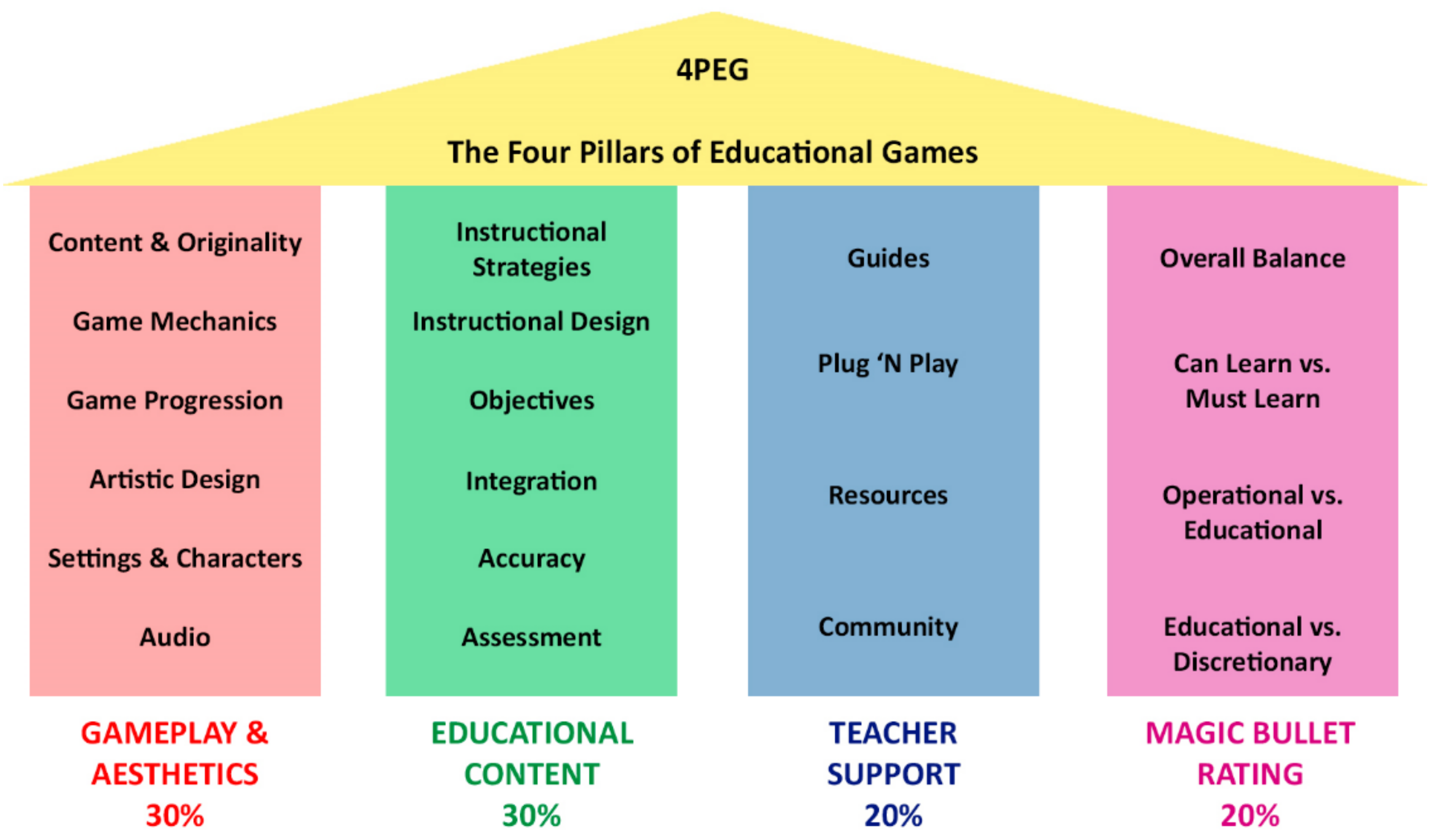
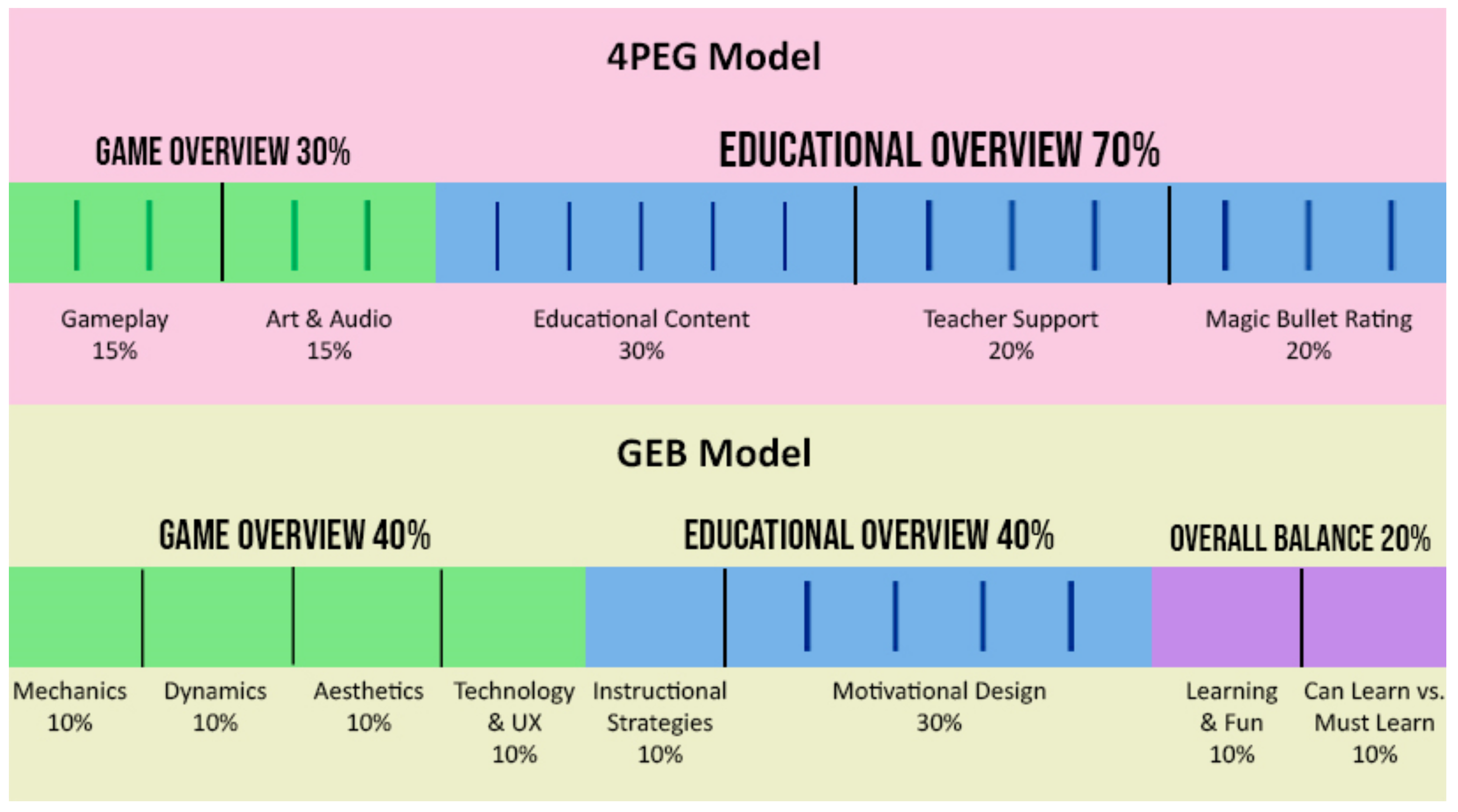
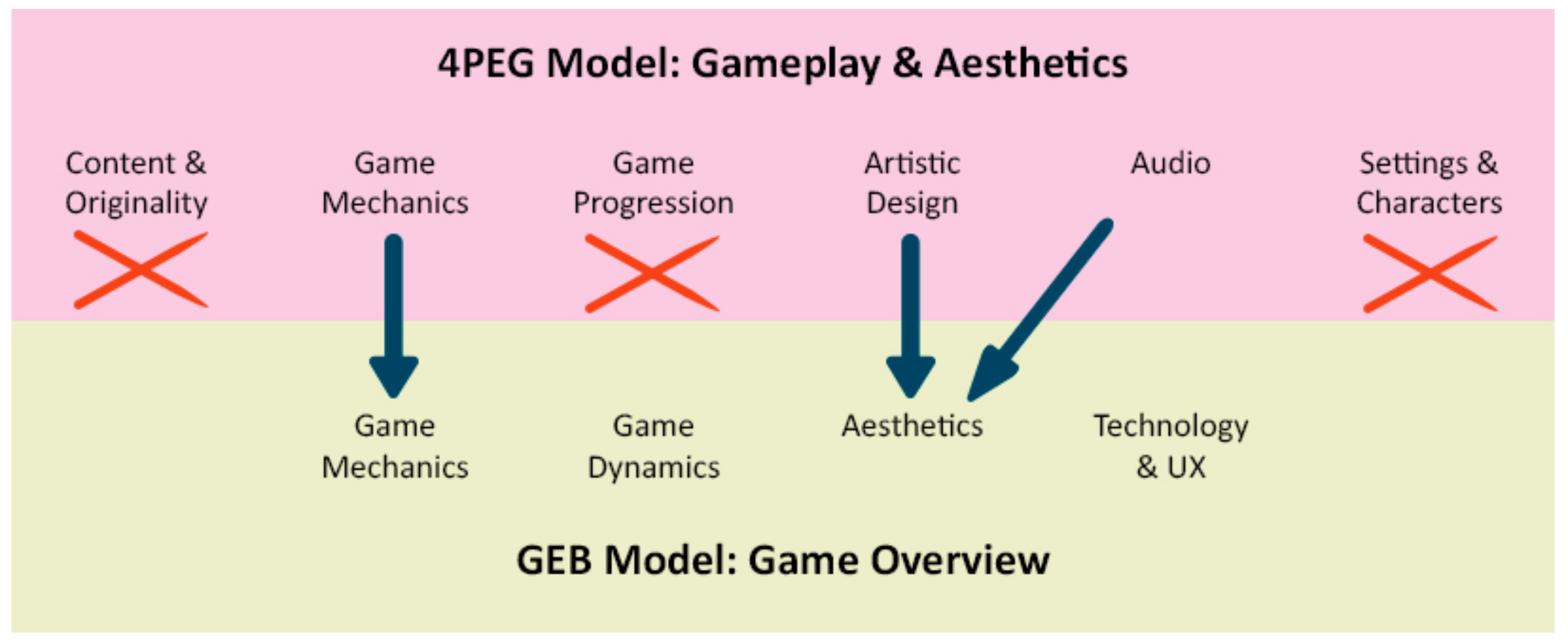
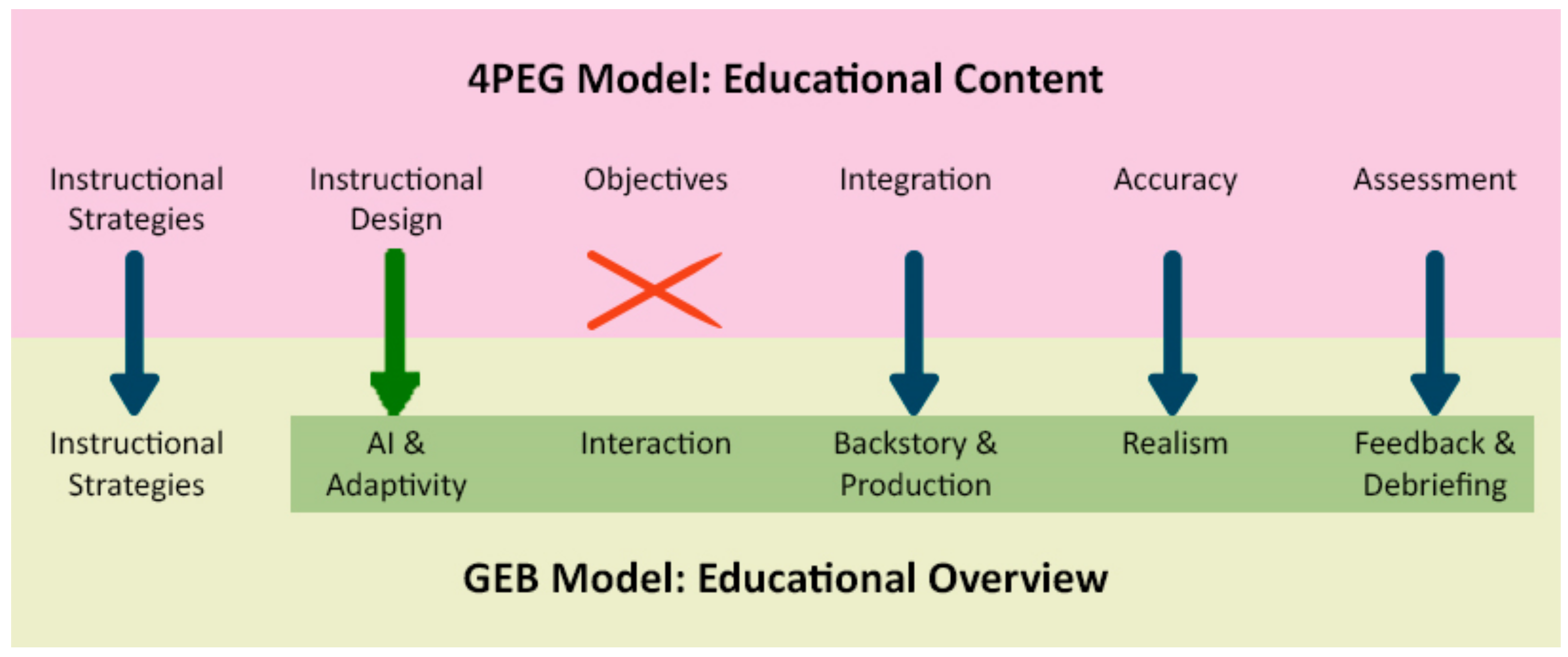
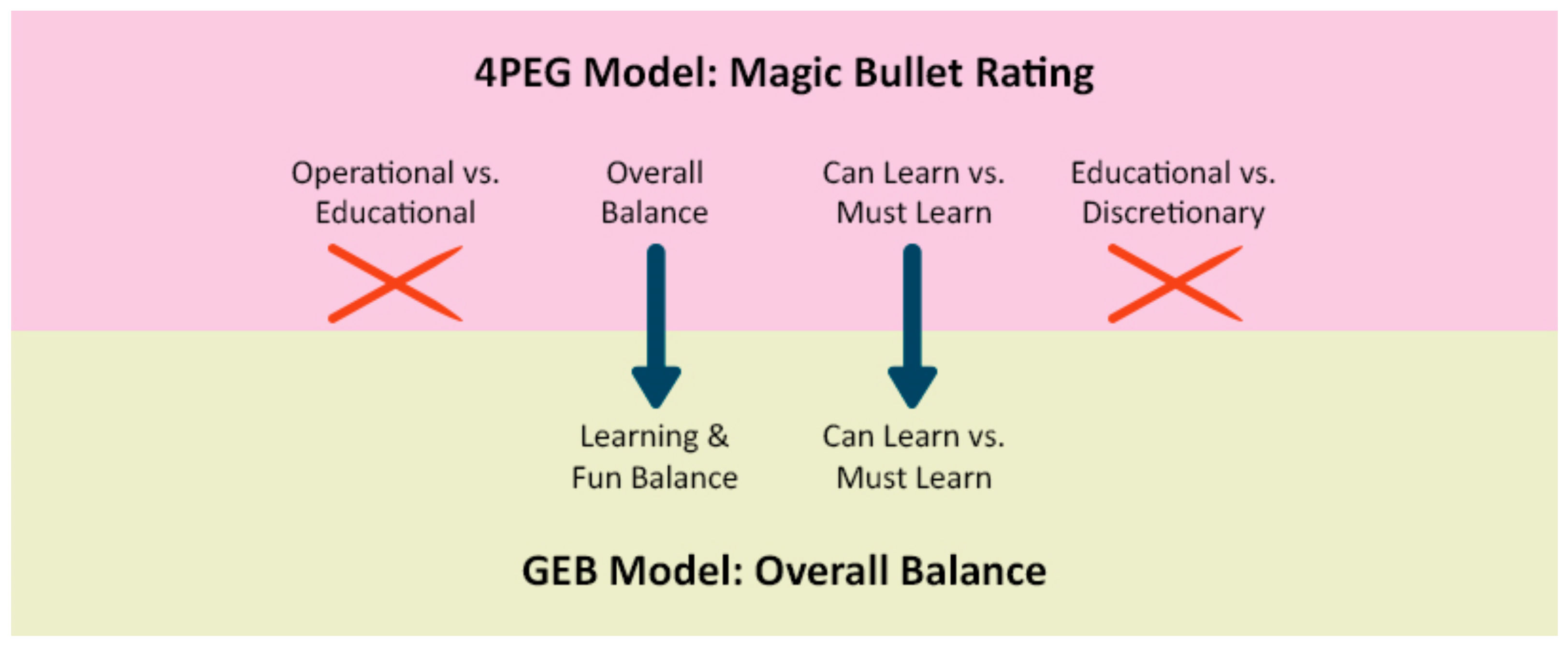
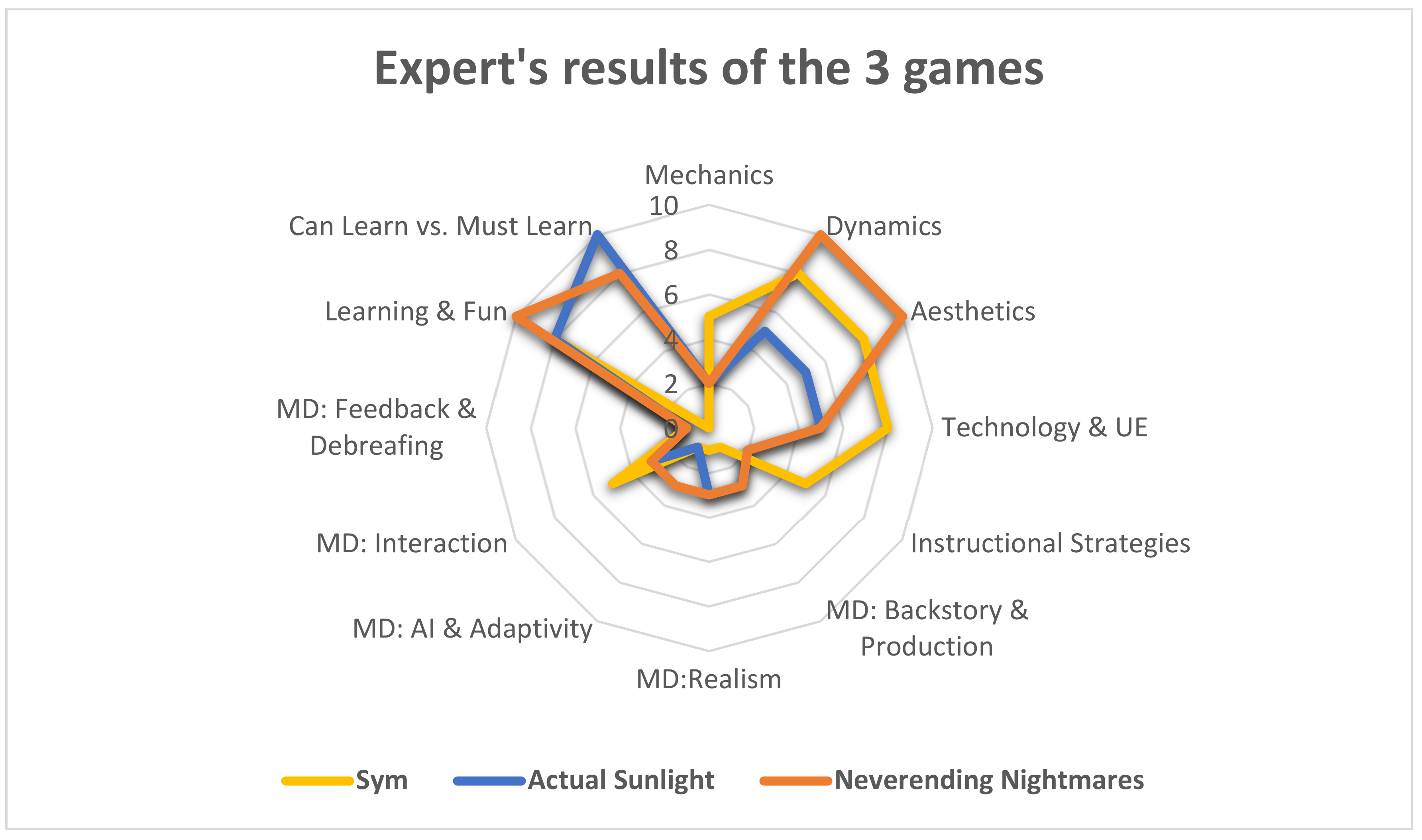
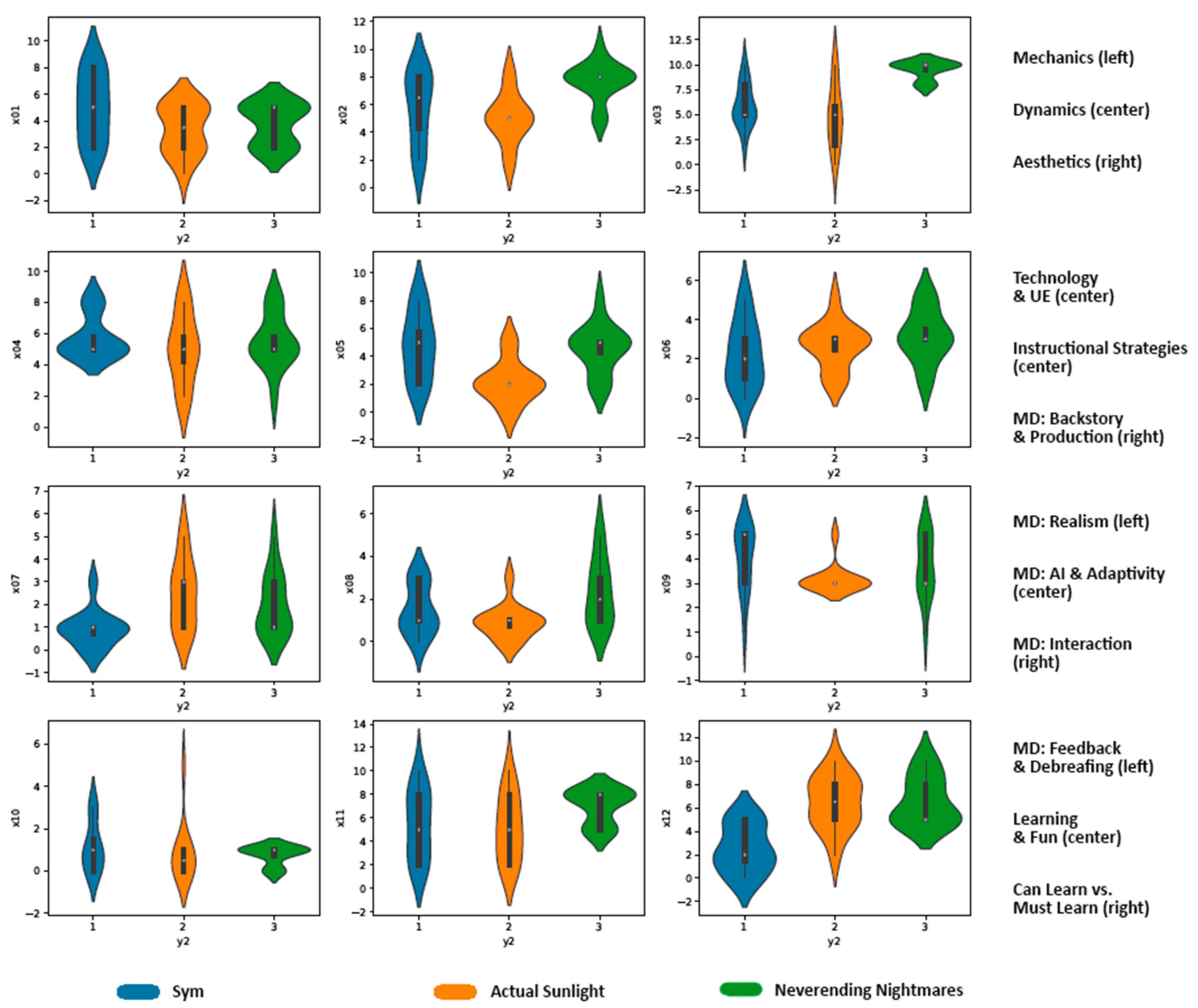
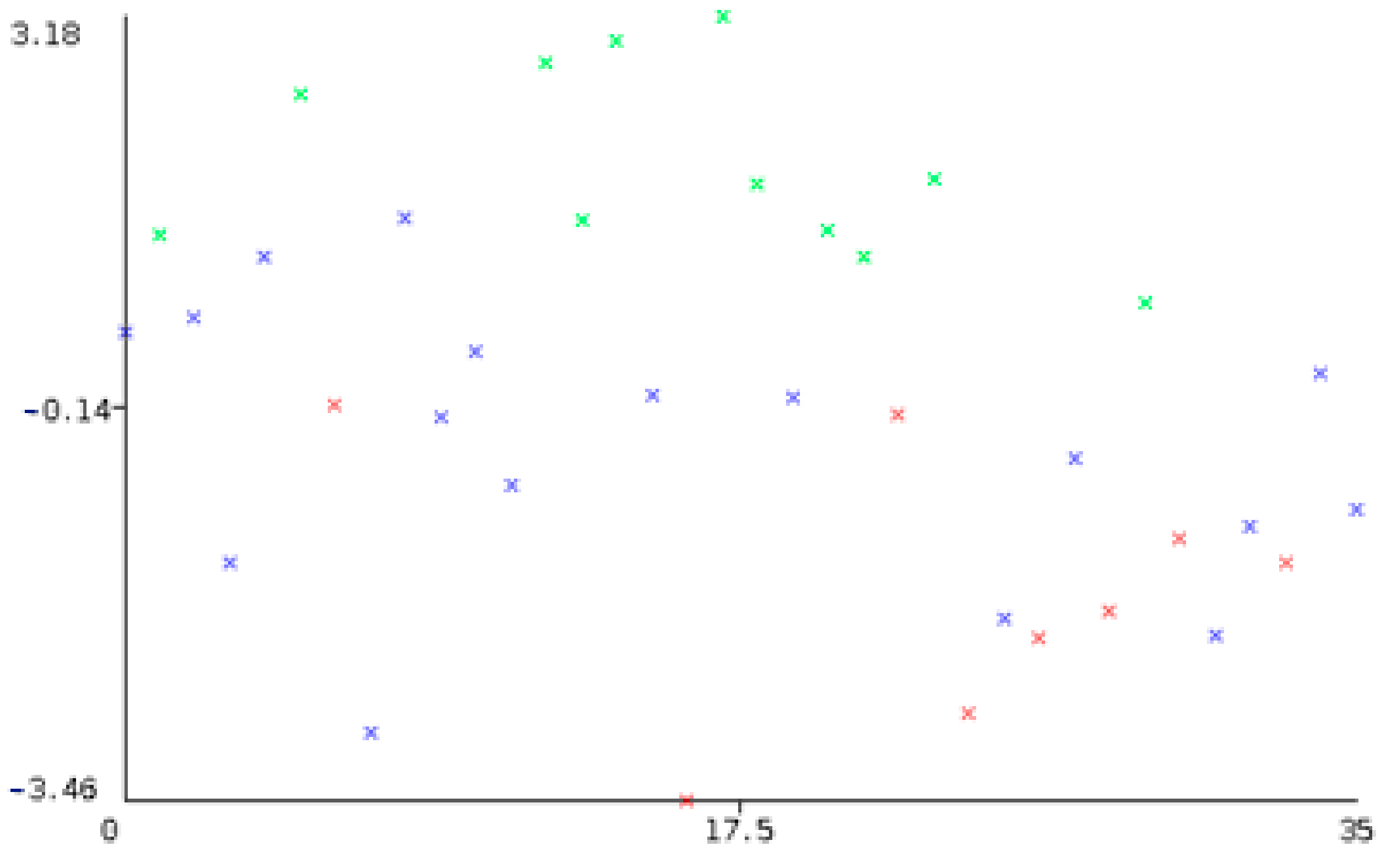
| Section | Feature | Punctuation | Evaluation |
|---|---|---|---|
| Game Overview | Game Mechanics | 10/8/5/2/0 | Levels, missions, rules, abilities, scores and leaderboards. Prizes and objects that are received when the objectives are achieved, as well as the responses of the characters, the choices of the players and the audios and videos. |
| Game Dynamics | 10/8/5/2/0 | Progressive difficulty, time patterns, possible strategies and scheduled rewards. Missions or characters to interact with, besides objects that can be unlocked or explored, and the possibilities of competition and cooperation. | |
| Aesthetics | 10/8/5/2/0 | Emotions such as love, beauty, friendship, delight, surprise, honor, laughter, envy, drama, chills or surprise. | |
| Technology and User Experience | 10/8/5/2/0 | Interface must motivate to play and be pleasant, also offering decision-making, self-perception of the actions and objectives of the game to give a sense of control. Everything in the short and long term. | |
| Educational Content | Instructional Strategies | 10/8/5/2/0 | Tests to acquire knowledge that avoid genres associated with learning, and introduce educational content through gameplay and narrative. In addition, the gameplay must be more relevant than the educational part. |
| Backstory and Production | 6/5/3/1/0 | An interesting plot, that does not interrupt the fun to introduce the educational content, and that allows to choose its development. | |
| Realism | 6/5/3/1/0 | Realistic graphics, sounds, and dynamics are engaging and help to focus. There are avatar customization options, and character interactions are expressive. | |
| AI and Adaptivity | 6/5/3/1/0 | AI or game interactions adapt features and difficulty to the player. | |
| Interaction | 6/5/3/1/0 | Interactions are easy and motivating, taught in a tutorial and progressively more complicated. In addition, there is collaborative interaction. | |
| Feedback and Debriefing | 6/5/3/1/0 | Feedback comes through rewards and character interactions. The teacher can help during the game, and a debriefing takes place. | |
| Overall Balance | Learning and Fun Balance | 10/8/5/2/0 | It’s fun while educational. Additionally, learning content is distributed throughout the game’s narrative while the controls become progressively more difficult. |
| Can Learn vs. Must Learn | 10/8/5/2/0 | Important learning is implemented in the main objectives. There is extra learning that is introduced in the exploration possibilities. There is not a large volume of information to distract from the game. |
| M | D | A | T and UE | IS | MD: B and P | MD: R | MD: AI and A | MD: I | MD: F and D | L and F | CL vs. ML | |
|---|---|---|---|---|---|---|---|---|---|---|---|---|
| M | 0 | 0.099 | 0.433 | 1.000 | 0.662 | 0.838 | 1.000 | 1.000 | 0.304 | 0.376 | 0.819 | 0.414 |
| 0.093 | 0.930 | 0.064 | 0.313 | 0.497 | 0.949 | 0.516 | 0.324 | 0.393 | 0.240 | 0.557 | ||
| 0.045 | 0.738 | 0.271 | 0.066 | 0.551 | 0.148 | 0.302 | 0.368 | 0.718 | 0.197 | 0.082 | ||
| D | 0.099 | 0 | 0.583 | 0.228 | 0.584 | 0.477 | 0.584 | 0.746 | 0.290 | 0.464 | 0.619 | 0.669 |
| 0.093 | 0.201 | 0.166 | 0.087 | 0.391 | 0.178 | 1.000 | 1.000 | 0.727 | 0.616 | 1.000 | ||
| 0.045 | 0.001 | 0.206 | 0.082 | 0.946 | 0.522 | 0.033 | 0.992 | 0.445 | 0.144 | 0.308 | ||
| A | 0.433 | 0.583 | 0 | 0.320 | 0.109 | 0.306 | 0.510 | 0.180 | 0.199 | 0.200 | 0.042 | 0.523 |
| 0.930 | 0.201 | 0.037 | 0.076 | 0.059 | 0.214 | 0.040 | 0.081 | 0.222 | 0.326 | 0.134 | ||
| 0.738 | 0.001 | 0.059 | 0.005 | 0.020 | 0.471 | 0.017 | 0.101 | 0.936 | 0.001 | 0.161 | ||
| T and UE | 1.000 | 0.228 | 0.320 | 0 | 0.606 | 0.573 | 0.606 | 0.671 | 0.465 | 0.491 | 0.917 | 0.443 |
| 0.064 | 0.166 | 0.037 | 0.426 | 0.148 | 0.278 | 0.302 | 0.148 | 0.385 | 0.683 | 0.123 | ||
| 0.271 | 0.206 | 0.059 | 0.181 | 0.556 | 0.703 | 0.759 | 0.301 | 0.239 | 0.790 | 0.811 | ||
| IS | 0.662 | 0.584 | 0.109 | 0.606 | 0 | 0.051 | 0.319 | 0.130 | 0.151 | 0.563 | 0.007 | 0.349 |
| 0.313 | 0.087 | 0.076 | 0.426 | 0.054 | 0.694 | 0.026 | 0.036 | 0.028 | 0.884 | 0.495 | ||
| 0.066 | 0.082 | 0.005 | 0.181 | 0.150 | 0.094 | 0.959 | 0.015 | 0.344 | 0.073 | 0.490 | ||
| MD: B and P | 0.838 | 0.477 | 0.306 | 0.573 | 0.051 | 0 | 0.275 | 0.002 | 0.114 | 0.210 | 0.194 | 0.896 |
| 0.497 | 0.391 | 0.059 | 0.148 | 0.054 | 0.717 | 0.045 | 0.022 | 0.066 | 0.068 | 0.479 | ||
| 0.551 | 0.946 | 0.020 | 0.556 | 0.150 | 0.555 | 0.699 | 0.037 | 0.912 | 0.031 | 0.168 | ||
| MD: R | 1.000 | 0.584 | 0.510 | 0.606 | 0.319 | 0.275 | 0 | 0.061 | 0.771 | 0.498 | 0.505 | 0.905 |
| 0.949 | 0.178 | 0.214 | 0.278 | 0.694 | 0.717 | 0.042 | 0.075 | 0.047 | 0.333 | 0.183 | ||
| 0.148 | 0.522 | 0.471 | 0.703 | 0.094 | 0.555 | 0.072 | 0.394 | 0.154 | 0.515 | 0.005 | ||
| MD: AI and A | 1.000 | 0.746 | 0.180 | 0.671 | 0.130 | 0.002 | 0.061 | 0 | 0.224 | 0.067 | 0.100 | 0.544 |
| 0.516 | 1.000 | 0.040 | 0.302 | 0.026 | 0.045 | 0.042 | 0.001 | 0.001 | 0.667 | 0.474 | ||
| 0.302 | 0.033 | 0.017 | 0.759 | 0.959 | 0.699 | 0.072 | 0.283 | 0.014 | 0.878 | 0.540 | ||
| MD: I | 0.304 | 0.290 | 0.199 | 0.465 | 0.151 | 0.114 | 0.771 | 0.224 | 0 | 0.486 | 0.151 | 0.568 |
| 0.324 | 1.000 | 0.081 | 0.148 | 0.036 | 0.022 | 0.075 | 0.001 | 0.001 | 0.356 | 0.587 | ||
| 0.368 | 0.992 | 0.101 | 0.301 | 0.015 | 0.037 | 0.394 | 0.283 | 0.027 | 0.152 | 0.794 | ||
| MD: F and D | 0.376 | 0.464 | 0.200 | 0.491 | 0.563 | 0.210 | 0.498 | 0.067 | 0.486 | 0 | 0.792 | 0.054 |
| 0.393 | 0.727 | 0.222 | 0.385 | 0.028 | 0.066 | 0.047 | 0.001 | 0.001 | 0.576 | 0.525 | ||
| 0.718 | 0.445 | 0.936 | 0.239 | 0.344 | 0.912 | 0.154 | 0.014 | 0.027 | 0.964 | 0.543 | ||
| L and F | 0.819 | 0.619 | 0.042 | 0.917 | 0.007 | 0.194 | 0.505 | 0.100 | 0.151 | 0.792 | 0 | 0.701 |
| 0.240 | 0.616 | 0.326 | 0.683 | 0.884 | 0.068 | 0.333 | 0.667 | 0.356 | 0.576 | 0.023 | ||
| 0.197 | 0.144 | 0.001 | 0.790 | 0.073 | 0.031 | 0.515 | 0.878 | 0.152 | 0.964 | 0.112 | ||
| CL vs. ML | 0.414 | 0.669 | 0.523 | 0.443 | 0.349 | 0.896 | 0.905 | 0.544 | 0.568 | 0.054 | 0.701 | 0 |
| 0.557 | 1.000 | 0.134 | 0.123 | 0.495 | 0.479 | 0.183 | 0.474 | 0.587 | 0.525 | 0.023 | ||
| 0.082 | 0.308 | 0.161 | 0.811 | 0.490 | 0.168 | 0.005 | 0.540 | 0.794 | 0.543 | 0.112 |
| Machine Learning Technique | Accuracy (%) | ROC Area |
|---|---|---|
| Näive-Bayes | 27.78 | 0.389 |
| KNN | 61.1 | 0.722 |
| Decision Trees | 58.33 | 0.762 |
| Multilayer Perceptron | 75.00 | 0.983 |
| Random Forest | 75.00 | 0.924 |
Publisher’s Note: MDPI stays neutral with regard to jurisdictional claims in published maps and institutional affiliations. |
© 2022 by the authors. Licensee MDPI, Basel, Switzerland. This article is an open access article distributed under the terms and conditions of the Creative Commons Attribution (CC BY) license (https://creativecommons.org/licenses/by/4.0/).
Share and Cite
Martinez, K.; Menéndez-Menéndez, M.I.; Bustillo, A. A New Measure for Serious Games Evaluation: Gaming Educational Balanced (GEB) Model. Appl. Sci. 2022, 12, 11757. https://doi.org/10.3390/app122211757
Martinez K, Menéndez-Menéndez MI, Bustillo A. A New Measure for Serious Games Evaluation: Gaming Educational Balanced (GEB) Model. Applied Sciences. 2022; 12(22):11757. https://doi.org/10.3390/app122211757
Chicago/Turabian StyleMartinez, Kim, María Isabel Menéndez-Menéndez, and Andres Bustillo. 2022. "A New Measure for Serious Games Evaluation: Gaming Educational Balanced (GEB) Model" Applied Sciences 12, no. 22: 11757. https://doi.org/10.3390/app122211757
APA StyleMartinez, K., Menéndez-Menéndez, M. I., & Bustillo, A. (2022). A New Measure for Serious Games Evaluation: Gaming Educational Balanced (GEB) Model. Applied Sciences, 12(22), 11757. https://doi.org/10.3390/app122211757






